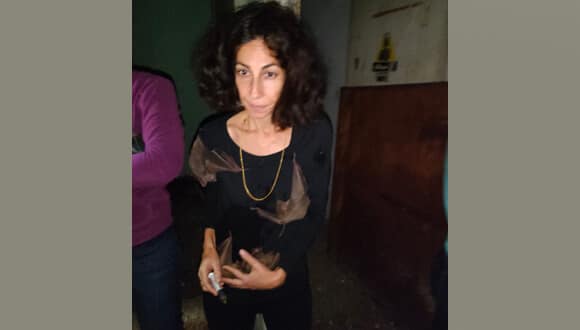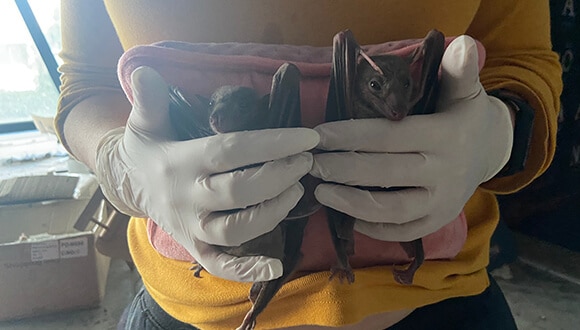How the zoology students rescued a huge colony of bats from a movie theater slated for demolition
The recent earthquakes reminded us again how important and necessary urban renewal is. Today, on almost every street in Tel Aviv, you can see a building that is at one stage or another of the TMA program to strengthen buildings, and there is no doubt that every such project saves human lives. But what happens to the animals that live in the vicinity of the buildings that are destined for demolition? During the last month, an impressive and complex evacuation operation of about 2,000 fruit bats took place from the mythical Palm Cinema building in the Babli neighborhood, with the cooperation of a team Prof. Yossi Yuval's bat laboratory from the School of Zoology at the George S. Wise Faculty of Life Sciences, Dr. Eran Levin, also from the Faculty of Life Sciences, the ecologist Shmulik Yadov from Safari and Tel Aviv Municipality. The team, which studies the behavior and physiology of bats throughout the year, got involved in the emergency operation and saved the lives of hundreds of individuals.
How many times did they get there in the dead of night? How do you catch bats that hover at a height of 15 meters? What treatment are given to them? And is there expected to be a permanent protocol that will ensure the evacuation of animals before the demolition of buildings? All the answers are here.
Colony from the movies
The Tel Aviv fruit bats live in colonies scattered throughout the city and choose every night (or actually every day) where to sleep. They usually congregate in a permanent colony, but sometimes they have alternative roosting colonies depending on the season and the fruits found in the city. The colonies are located in dark and quiet places, mainly in parking lots or abandoned buildings. The amount of individuals in a colony can range from a few hundred to a few thousand. Such was the colony of Dekel Cinema, which stood abandoned for three decades and is now about to become a 10-story residential building.
Since these are wild animals protected by law, the developer received from the Nature and Parks Authority (RTG) a permit for evacuations, as required by law, and when the demolition phase came, he turned to the Tel Aviv municipality, to check what should be done with the approximately XNUMX flying movie enthusiasts who live in the hall. Together with the ecologist Shmulik Yadov, head of wildlife at Safari and former director of the Mammal Center of the Society for the Protection of Nature, and Dr. Eran Levin from the School of Zoology at the George S. Wise Faculty of Life Sciences, they began the evacuation.
"Theoretically, the idea was simple: locate all the openings to the hall and close them after the bats go out to look for food. They move to another colony they know, and that way the animals are not harmed," explain doctoral student Ofri Eitan and veterinarian Dr. Maya Weinberg, both researchers in Prof. Yossi Yuval's bat laboratory, who took an active part in the operation. "It was important to evacuate the colony before the calving season begins in the spring, in order to spare the puppies and the mothers the move that could lead to high mortality. Luckily for us, the winter weather was bright and comfortable these days."
The openings were located, and at dusk when the bats came out to eat they were sealed with nets. But at the end of the first night it turned out that several hundred details remained inside. Now the more complex evacuation phase began and this is where our students came into action.
Instead of popcorn - mango juice
"After the first night, some of the bats we found in the movie theater suffered from hypothermia and dehydration and needed treatment, since they had no access to food and water while they were inside," says Ofri. Most of them were very accessible - they hung on the net that blocked the exit and it was easy to grab them to treat and release.
Under the direction of Dr. Maya Weinberg, a team of volunteers from the laboratory was rushed, including Prof. Yossi Yuval, who arrived at the scene in the late afternoon hours with headlamps, heating bags, syringes and carriers and with a lot of love and intention to help. With the help of the contractor Aliko Shelby (pigeon repeller by trade), who came on behalf of the developer, they opened the screen of the main opening to allow those inside to exit, kept them from going back in, and then closed it late at night. "He was happy to help in whatever way he could," says Maya. "It's exciting to see the commitment of all parties concerned for the sake of bats. Even the group of Babli mothers rallied and brought a cutting board, knives and fruit bowls for the neighborhood bats, who received a lot of care and dedicated care that night."
"They were frozen, so until the heating bags arrived, we simply attached them to us to warm them up and watered them with fruit juice that we bought at the adjacent shopping center, in order to provide them with liquids and a concentrated dose of sugar," says Maya. According to her, fruit bats consume their body weight in food every night, and the fact that it is the month of January, which is cold and already considered the peak of the pregnancy season, did not contribute to the condition of the bats.


They did this for several nights until only a few dozen bats remained, which had to be physically captured using long poles about 10 meters long and nets, which is not easy when it comes to a place with a ceiling at least 20 meters high. At the same time as the capture attempts that lasted for about two weeks, the team left bananas and apples on the nets every night so that the bats could come and eat.
One would expect that the individuals left behind would be the weaker ones, but surprisingly, Ofri says that these are actually the strongest and most suspicious individuals in the group. "These are bats that knew how to evade the traps we set for them and managed to survive without a food source for several days, did not suffer from hypothermia and did not reach a life-threatening situation."
until the last at bat
Finally, there was only one bat left in the movie theater, which was named Phantom. "People said to me: 'Why are you trying so hard for one bat?', but in my opinion, beyond the fact that it is an animal's life, I certainly cannot give up this bat, because it is apparently a very successful bat that knew how to survive all the difficult conditions , and he deserves to be released and join his friends. By the way, I don't even know if it's a male or a female, because we never managed to catch him", says Ofari fondly.
"Every bat is worth a fight", Maya reinforces his words. "This is an animal that can live 40 years, and it is protected and has such an important part in the ecological cycle. That's why the insistence of Ofri, and of everyone who did everything voluntarily and of his own good will, is worthy of appreciation. I am proud to be in the laboratory with such people", she adds. Shmulik Yadov, the ecologist who accompanied the process from the beginning, and Elikan Shelvi the contractor also continued to come almost every evening and help.
In the following nights, Oferi left food at the place, and after Phantom was no longer seen in the hall, he assumed and hoped that he managed to get out. It's very possible that he didn't even leave the neighborhood - Ofri discovers that some of the bats took up residence in the parking lot under the cinema.
"In the end, someone who cares will run with the network, and we will be happy to help and guide as much as necessary to make it happen"
The new protocol
At the end of the move, Maya contacted RTG and asked what the written procedure was regarding the removal of fruit bats from buildings that are candidates for demolition. It turns out there isn't one. "Currently, the authority grants a permit, but there is no protocol to follow," she says. She picked up the gauntlet and took it upon herself to draw up a protocol in front of RTG's scientific division, so that the issue would receive a reference of a binding law. "I wrote a very detailed preliminary version that explains the importance of the species and its way of life, and recommendations for a nocturnal and gradual evacuation method, and it is currently in drafts before RTG. At the same time, we are working for the procedure to be approved as part of it Coach Eurobats (agreement on the conservation of European bat populations), which Israel is committed to and is proud to be a member of. We learned a lot from this evacuation, and even if we know it's impossible to achieve 100% success, that's always the ambition."
At the moment, the procedure only concerns fruit bats and of course there are other animals that live in the yards of the houses and inside them, such as insect bats, hedgehogs, bird species and more, and for them also we have to act. "We will get there as well, but in the meantime, every day a building is destroyed, we want to move forward with it. We will build it in a practical and applicable way, and then we will mediate it to the field, municipalities, contractors and entrepreneurs, who will have to train and teach individually. In the end, someone who cares will run with the network, and we will be happy to help and guide as much as necessary to make it happen", she concludes.
The team of the bat laboratory that took part in the operation: Prof. Yossi Yuval, Dr. Maya Weinberg, Ofri Eitan, Adi Rahum, Goni Naamani, Ksenia Kriboruchko, Liraz Atia, Zohar Kaufman and Dean Zigdon.
More of the topic in Hayadan:
- What is the mysterious vision problem that blinds octopuses?
- There is no scientific evidence that the corona came from bats
- When neurons change gears: how the brain copes with sudden changes
- Two Israeli studies on the ability of bats to build a cognitive map are featured in the Science cover today
- The "super-sensory" watch of bats
